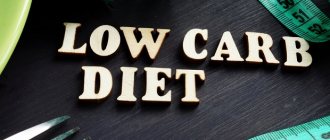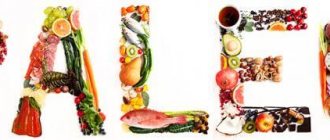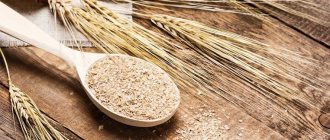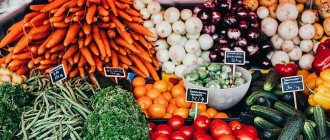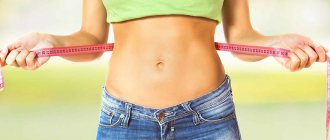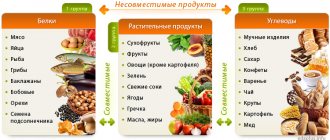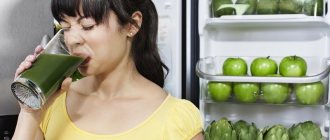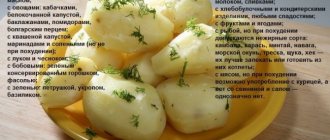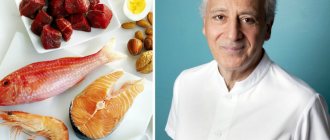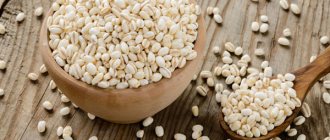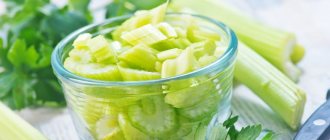© designer491 — depositphotos.com
Share:
The no-carbohydrate diet is considered the most “mild” or easily tolerated of all modern diets, despite the complete exclusion of carbohydrates from the diet. It is designed for weight loss and is truly effective in eliminating subcutaneous fat. What to eat and what not to eat on a low-carb diet? How to get out of a diet so that the lost pounds don’t come back? Read about it in our article.
Basic diet rules
This program was developed specifically for bodybuilders participating in competitions and championships, but, like many other nutrition systems, it went beyond the framework of professional sports.
Protein foods and a small amount of vegetable fats are the main emphasis of this diet. Limiting the amount of carbohydrates, although maximum, is not complete. It is still advisable to consume 30-40 g of carbohydrates per day for normal functioning of the intestines and stomach. Excluding them completely from the diet increases the risk of developing constipation and other digestive disorders.
Spices
To give a dish or dessert a unique flavor, all kinds of spices are used:
- Turmeric;
- Saffron;
- Peppers;
- Cinnamon;
- Ginger;
- Basil;
- Khmeli-suneli;
- Apple vinegar;
- Cocoa powder;
- Soy sauce.
Seasonings will help create a feeling of fullness, and they contain virtually no carbohydrates.
The essence of the diet
This method of nutrition is based on the principle of burning subcutaneous fat by the body itself in conditions of constant lack of energy from carbohydrates consumed in food.
Without consuming carbohydrates, those losing weight experience ketosis, a state in which the body obtains energy from the breakdown of fat cells. Ketosis is considered a physiological state, in contrast to ketoacidosis, a pathology in which the number of ketone bodies in the blood critically increases. Long-term ketoacidosis is dangerous to life and health. For this reason, people transition to ketosis gradually. It is recommended to adhere to a safe ratio: 50% proteins, 35-40% fats, and 10-15% carbohydrates.
© NinaMunha — depositphotos.com. Non-carbohydrate food pyramid
The body's response to carbohydrate withdrawal
In the first week of a new diet, no visible changes occur in the body. There is either very little weight loss or no weight loss at all. At the initial stage, the body gets used to receiving energy not from foods rich in carbohydrates, but from its own fat reserves.
Reducing carbohydrates may cause drowsiness and slight weakness. The body's reaction may also be constipation. Increasing the volume of protein foods puts a strain on the liver and kidneys. Another common reaction of the body to this diet is mild stress and even depression due to the fact that the brain receives less glucose.
Burning fat on this diet does not require intense daily workouts.
Diet stages
The body’s gradual transition to consuming energy from broken down fat cells occurs in 4 stages.
- First stage. Consuming carbohydrates only in the morning. A few hours after breakfast, the supply of glucose obtained from the morning meals will expire, and the body will begin to waste its own glycogen reserves.
- Second phase. Complete exclusion of glucose from food. Glycogen from muscle cells and the liver is used to produce energy. After 2-3 days, the body feels a constant lack of carbohydrates and begins to “look” for an alternative for energy production.
- The third stage occurs 3-4 days after the start of the diet. There is almost no glycogen in the cells of the body. Fat burning is activated, but to provide the body with energy, the body resorts to proteins. You will need to eat more protein in the first week than in subsequent weeks to compensate for the increased protein consumption.
- Fourth stage. Ketosis starts. The breakdown of fat cells to produce energy begins.
Contraindications
Contraindications to the use of BCH are:
- pregnancy and breastfeeding;
- kidney disease, gastrointestinal tract, genitourinary system;
- cholelithiasis;
- individual intolerance to the proposed products.
Nutrition organized according to the principle of alternation requires self-organization and control from those losing weight. At the slightest ailment or in case of illness, you should return to your normal diet and focus on health, not weight loss.
Types of low-carbohydrate diet
Several varieties of this nutrition program are practiced: constant, circular and power. Each of them has its own characteristics.
Power
Suitable only for professional athletes. Its essence is to take carbohydrates before training, so that you have the strength to fully work with heavy physical activity. This approach is only justified with an intensive training program. Otherwise, you will not waste the carbohydrates received in full and will not lose weight.
Constant
You consume no more than 20 grams of carbohydrates per day with fiber. The emphasis in the diet is on proteins and vegetable fats. By completely giving up carbohydrates, you risk experiencing psychomotor retardation, absent-mindedness, and decreased speed of thinking and perception.
Circular
This approach consists of reducing carbohydrate intake to 30-40 g in vegetables and cereals. The restriction lasts 6 days. On the seventh day, a full carbohydrate “load” occurs. You are allowed to eat porridge, vegetables, pasta, and a couple of fruits.
Loading starts the production of enzymes, stimulates metabolic processes and enriches muscle cells with glycogen. By practicing this approach, you will work fully, feel great, and avoid all the negative effects of eliminating carbohydrates.
Carbohydrates: which ones you can, which ones you can’t
Carbohydrates (sugars) or cargo are special organic compounds necessary for the life of people, animals and plants. In the process of photosynthesis of the latter, the planet receives this important component.
For humans, carbohydrates perform a lot of essential functions. Among the most important are plastic and energy. Being part of more complex molecules, cargos participate in the construction of DNA. But most of all, these compounds are known as the main source of energy for the functioning of the body. Once inside, they oxidize, releasing energy. When 1 gram of carbohydrates breaks down, 4.1 kcal and 0.4 g of water are released.
Content:
- Carbohydrates: which ones you can, which ones you can’t
- The essence of the carbohydrate diet
- Carbohydrate menu
- Calendula decoction for carbohydrate diet
- Mathematical Carbohydrate Diet
- Cream of mushroom soup with celery
- Strict carbohydrate diet
- Advantages and disadvantages
- Carbohydrate diet: what the doctor says
Sugars are made up of special structural units. Depending on the number of these units, they are distinguished: monosaccharides (1 unit), disaccharides (2 units), oligosaccharides and the most complex ones - polysaccharides. It is precisely the latter that are the saviors in the carbohydrate diet.
All simple carbohydrates contain a high glycemic index (sucrose, fructose, glucose, lactose). Once in the stomach, they are quickly digested and converted into sugar. The “cunning” human body is very complex and cannot be easily deceived. In order to prevent hyperglycemia, it simply transforms sugar into fat. This process, from the “point of view” of the human body, is very useful, since stored fat is a guarantee of an energy source for a rainy day. This is the trap for all obese people: with a sharp drop in blood glucose, a feeling of hunger appears. Therefore, when a person eats sweets, he continues to want to eat.
Another thing is complex carbohydrates. These are, first of all, glycogen, starch and cellulose. These components consist of many structural units. Therefore, it takes more time and, most importantly, energy to digest and process them.
List of approved products
Allowed foods during a carbohydrate-free diet include boiled or baked fish, boiled red meat (rabbit, beef), poultry fillet boiled or in steam cutlets, dairy products with a protein content of no more than 5%.
Vegetables
Green vegetables are allowed: lettuce, cucumber, cilantro, parsley, white cabbage, dill and some fruits: sour green apples, coconut, citrus fruits, peaches.
Nuts
It is recommended to eat nuts. This is a source of fat. Several times a week, try to eat a handful of peanuts, hazelnuts and any other nuts.
Cereals
Supplement your diet with buckwheat and millet. It is allowed to eat side dishes of stewed or baked zucchini, asparagus, and eggplant.
© NinaMunha — depositphotos.com
Table of permitted products
The list of products indicated for consumption is extensive. Use it as a base for your low-carb diet. The calorie content of each type of product is indicated per 100 grams.
Table of allowed foods during a low-carbohydrate diet:
| Products | Proteins, grams | Fats, grams | Carbohydrates, grams | Calories, Kcal |
| Vegetables and greens | ||||
| eggplant | 1,2 | 0,1 | 4,5 | 24 |
| peas | 6 | – | 9 | 60 |
| zucchini | 0,6 | 0,3 | 4,6 | 24 |
| cabbage | 1,8 | 0,1 | 4,7 | 27 |
| broccoli | 3 | 0,4 | 5,2 | 28 |
| cabbage | 1,2 | 0,2 | 2 | 16 |
| cilantro | 2,1 | 0,5 | 1,9 | 23 |
| leek | 2 | – | 8,2 | 33 |
| bulb onions | 1,4 | – | 10,4 | 41 |
| cucumbers | 0,8 | 0,1 | 2,8 | 15 |
| olives | 0,8 | 10,7 | 6,3 | 115 |
| squash | 0,6 | 0,1 | 4,3 | 19 |
| sweet green pepper | 1,3 | – | 7,2 | 26 |
| parsley | 3,7 | 0,4 | 7,6 | 47 |
| radish | 1,2 | 0,1 | 3,4 | 19 |
| arugula | 2,6 | 0,7 | 2,1 | 25 |
| salad | 1,2 | 0,3 | 1,3 | 12 |
| asparagus | 1,9 | 0,1 | 3,1 | 20 |
| tomatoes | 0,6 | 0,2 | 4,2 | 20 |
| dill | 2,5 | 0,5 | 6,3 | 38 |
| garlic | 6,5 | 0,5 | 29,9 | 143 |
| lentils | 24,0 | 1,5 | 42,7 | 284 |
| Fruits | ||||
| oranges | 0,9 | 0,2 | 8,1 | 36 |
| grapefruit | 0,7 | 0,2 | 6,5 | 29 |
| lime | 0,9 | 0,1 | 3 | 16 |
| lemons | 0,9 | 0,1 | 3 | 16 |
| tangerines | 0,8 | 0,2 | 7,5 | 33 |
| peaches | 0,9 | 0,1 | 11,3 | 46 |
| pomelo | 0,6 | 0,2 | 6,7 | 32 |
| sweetie | 0,7 | 0,2 | 9 | 58 |
| apples | 0,4 | 0,4 | 9,8 | 47 |
| Nuts and dried fruits | ||||
| cashew | 25,7 | 54,1 | 13,2 | 643 |
| coconuts | 3,4 | 33,5 | 6,2 | 354 |
| almond | 18,6 | 57,7 | 16,2 | 645 |
| pistachios | 20 | 50 | 7 | 556 |
| hazelnut | 16,1 | 66,9 | 9,9 | 704 |
| Cereals and porridges | ||||
| buckwheat | 4,5 | 2,3 | 25 | 132 |
| quinoa | 14,1 | 6,1 | 57,2 | 368 |
| Dairy | ||||
| skim milk | 2 | 0,1 | 4,8 | 31 |
| kefir 1% | 2,8 | 1 | 4 | 40 |
| sour cream 10% (low-fat) | 3 | 10 | 2,9 | 115 |
| Ryazhenka 1% | 3 | 1 | 4,2 | 40 |
| natural yogurt 2% | 4,3 | 2 | 6,2 | 60 |
| Cheeses and cottage cheese | ||||
| cheese | 24,1 | 29,5 | 0,3 | 363 |
| cottage cheese 0% (low fat) | 16,5 | – | 1,3 | 71 |
| Meat products | ||||
| pork | 16 | 21,6 | – | 259 |
| pork liver | 18,8 | 3,6 | – | 108 |
| beef | 18,9 | 19,4 | – | 187 |
| beef liver | 17,4 | 3,1 | – | 98 |
| beef kidneys | 12,5 | 1,8 | – | 66 |
| beef heart | 15 | 3 | – | 87 |
| beef tongue | 13,6 | 12,1 | – | 163 |
| beef brains | 9,5 | 9,5 | – | 124 |
| veal | 19,7 | 1,2 | – | 90 |
| mutton | 15,6 | 16,3 | – | 209 |
| rabbit | 21 | 8 | – | 156 |
| venison | 19,5 | 8,5 | – | 154 |
| horsemeat | 20,2 | 7 | – | 187 |
| bacon | 23 | 45 | – | 500 |
| ham | 22,6 | 20,9 | – | 279 |
| cutlets | 16,6 | 20 | 11,8 | 282 |
| steak | 27,8 | 29,6 | 1,7 | 384 |
| pork meatballs | 7 | 10 | 12 | 172 |
| Bird | ||||
| chicken | 16 | 14 | – | 190 |
| turkey | 19,2 | 0,7 | – | 84 |
| duck | 16,5 | 61,2 | – | 346 |
| Eggs | ||||
| omelette | 9,6 | 15,4 | 1,9 | 184 |
| chicken eggs | 12,7 | 10,9 | 0,7 | 157 |
| quail eggs | 11,9 | 13,1 | 0,6 | 168 |
| Fish and seafood | ||||
| flounder | 16,5 | 1,8 | – | 83 |
| salmon | 19,8 | 6,3 | – | 142 |
| mackerel | 20,7 | 3,4 | – | 113 |
| herring | 16,3 | 10,7 | – | 161 |
| cod | 17,7 | 0,7 | – | 78 |
| tuna | 23 | 1 | – | 101 |
| trout | 19,2 | 2,1 | – | 97 |
| Oils and fats | ||||
| vegetable oil | – | 99 | – | 899 |
| Non-alcoholic drinks | ||||
| lingonberry juice | 0,1 | – | 10,7 | 41 |
| green tea | – | – | – | – |
Download the table of foods allowed on a low-carbohydrate diet here so that you always have it at your fingertips.
© JuliaMikhaylova — depositphotos.com
Diet recipes
There are a huge number of foods allowed on a hypocarbohydrate diet. This makes it possible to come up with a wide variety of tasty and healthy dishes. They are easy to prepare at home. You can use either ready-made recipes or develop them yourself. The main thing is to adhere to the basic principles:
- cook mainly by steaming or in the oven;
- Use lemon juice instead of salt as a seasoning for dishes.
Squid salad
Ingredients:
- chicken egg - 1 or 2 pieces;
- squid – 150 grams;
- canned corn – 70 grams;
- cucumber – 1 piece;
- lemon juice, olive oil
Preparation:
- Leave the boiled eggs under cold water for a few minutes. Clear.
- Cut into small pieces of any shape.
- Rinse the squid well under cold water. Place in boiling water for 3 minutes.
- Cut them and the cucumber into thin strips.
- Mix all ingredients.
- Season with lemon juice or olive oil. Mix again. Serve.
Chicken fillet stewed in a slow cooker
Used:
- chicken fillet – 260 grams;
- water – 160 milliliters;
- ground black pepper to taste;
- tomato paste – 60 milliliters;
- bay leaf - 2 pieces.
Preparation:
- Wash the meat thoroughly and remove excess moisture with a towel.
- Cut into portions, pepper and salt.
- Place in a slow cooker. Add bay leaf, paste, water.
- Mix.
- Turn on “Quenching” for 1.5 hours.
Chicken stewed in pots
Components:
- spinach – 400 grams;
- greens - a bunch;
- vegetable broth - 240 milliliters;
- chicken meat – 500 grams;
- broccoli – 300 grams;
- wine – 100 milliliters;
- onion – 1 piece;
- carrots – 2 pieces;
- apple juice – 70 milliliters.
How to cook:
- Wash and chop the vegetables. Divide the cabbage into florets.
- Cut the chicken meat into small pieces.
- Chop the greens.
- Mix. Add spices to taste.
- Juice, wine, broth are useful as a marinade.
- Place all ingredients into pots. Add marinade.
- Cover with foil.
- Place in a preheated oven (180°C). Bake for an hour.
Vegetable soup with beef meatballs
You will need:
- onion – 80 grams;
- chicken egg - 1 piece;
- bay leaf – 5 pieces;
- beef meat – 415 grams;
- pepper – 180 grams;
- cauliflower – 200 grams;
- meat seasoning - to taste;
- greens – 50 grams.
Cooking:
- Grind the beef until minced. No need to wash.
- Add the egg. Spice up. Add salt. Form into small balls
- Chop the vegetables. Chop the greens. Shred the cabbage.
- Boil water.
- Cook meatballs and other preparations for 17 minutes.
- Add greens. Serve the dish.
Vegetarian borscht
Components:
- water – 1.7 liters;
- beets - 1 piece;
- dill – 10 grams;
- onions – 1 piece;
- parsley – 10 grams;
- tomato paste – 30 grams;
- carrots - 1 piece;
- salt - 1 gram.
Cooking:
- Peel the beets and cook until soft over low heat.
- Sauté onions and carrots. Use a small amount of vegetable oil.
- Grind the beets on a coarse grater.
- Add all the ingredients to the resulting beet broth.
- Add pasta and salt after boiling water.
- When setting the table, decorate the plate with the dish with chopped herbs.
Dried chicken breasts
Products:
- chicken breast – 500 grams;
- cognac – 110 milliliters;
- salt.
Necessary:
- Rub the chicken breast with salt.
- Place in a glass container and add cognac. Cover with cling film. Place in the refrigerator for two days. Take out and stir twice a day.
- Rinse the meat. Leave in cold water for 20 minutes. Remove and dry with towels.
- Wrap the pieces of meat in a linen towel and leave in the refrigerator for two days.
- Steam the meat over the stove for 3 hours.
Oat bran soup
What to take:
- onion – 1 piece;
- chopped dill - 1.5 tablespoons;
- turkey – 170 grams;
- green bow – 3 arrows;
- chicken egg – 1 piece;
- water – 1.2 liters;
- oat bran - 300 grams;
- salt to taste.
How to cook:
- Cut the meat into small pieces. Boil in brackish water for 20 minutes.
- Add greens and onions. Smash
- Cook for 7 minutes. Add bran.
- After 15 minutes, remove from heat.
Salad with Chinese cabbage and fruits
Need to:
- head of cabbage - 1 piece;
- apple - 1 piece;
- citrus fruits or grapefruit – 1 piece;
- lemon juice – 30 milliliters;
- green onions – 10 grams;
- salt - to taste.
Process:
- Peel the orange. Cut the pulp into large slices.
- Cut the apple into cubes.
- Shred the cabbage. Add to fruit.
- Add herbs, salt. Season with lemon juice.
Meat with cheese in the oven
Required:
- feta cheese – 120 grams;
- veal – 450 grams;
- refined vegetable oil – 40 milliliters;
- milk – 110 milliliters;
- salt as desired.
Instructions:
- Rinse the meat under running cold water. Cut. Beat it off.
- Place in a mold, having previously greased it with oil.
- Salt and pepper. Pour milk.
- Place in an oven preheated to 190°C. Time: 60 minutes.
- Remove from oven. Garnish with slices of cheese.
- Return it back. Bake for another 30 minutes.
White fish with vegetables
Ingredients:
- white fish – 0.5 kilograms;
- tomato – 3 pieces;
- eggplants - 1 piece;
- salt - optional.
Actions:
- Cut the fish into small portions.
- Sprinkle with salt.
- Place on a baking sheet with vegetables.
- Bake at 180°C for an hour.
- The dish will be more appetizing in combination with eggs, salads or sauce.
Partially restricted and prohibited products
Although this nutritional program is varied and not considered too strict, you will still have to give up some foods. The first to be banned are packaged juices, fruit drinks, and sparkling water. You should not eat fresh starchy foods: potatoes, beets, carrots and corn. You should also avoid products labeled “low-calorie,” “low-fat,” “light,” or “diet.”
The strictest ban applies to alcoholic beverages and fast food, as well as all kinds of cakes, pastries and sweets from the supermarket. Also prohibited “treats” include smoked foods: sausages, smoked chicken, smoked fish. A partial ban applies to frozen foods: green frozen vegetables can be used to prepare a side dish. Flour products (bread), including homemade baked goods, are prohibited. The only exception is pasta, which needs to be cooked for longer than 5 minutes.
Table of foods that are prohibited on a low-carbohydrate diet:
| Products | Proteins, grams | Fats, grams | Carbohydrates, grams | Calories, Kcal | ||||
| Vegetables and greens | ||||||||
| corn | 3,5 | 2,8 | 15,6 | 101 | ||||
| carrot | 1,3 | 0,1 | 6,9 | 32 | ||||
| Fruits | ||||||||
| bananas | 1,5 | 0,2 | 21,8 | 95 | ||||
| persimmon | 0,5 | 0,3 | 15,2 | 66 | ||||
| Berries | ||||||||
| grape | 0,6 | 0,2 | 16,6 | 65 | ||||
| Cereals and porridges | ||||||||
| semolina | 3,0 | 3,2 | 15,3 | 98 | ||||
| white rice | 6,7 | 0,7 | 78,9 | 344 | ||||
| Flour and pasta | ||||||||
| wheat flour | 9,2 | 1,2 | 74,9 | 342 | ||||
| pasta | 10,4 | 1,1 | 69,7 | 337 | ||||
| pancakes | 6,1 | 12,3 | 26 | 233 | ||||
| vareniki | 7,6 | 2,3 | 18,7 | 155 | ||||
| dumplings | 11,9 | 12,4 | 29 | 275 | ||||
| Bakery products | ||||||||
| sliced loaf | 7,5 | 2,9 | 51 | 264 | ||||
| wheat bread | 8,1 | 1,0 | 48,8 | 242 | ||||
| Confectionery | ||||||||
| candies | 4,3 | 19,8 | 67,4 | 453 | ||||
| Raw materials and seasonings | ||||||||
| sugar | – | – | 99,6 | 398 | ||||
| Cheeses and cottage cheese | ||||||||
| curd mass with raisins | 6,8 | 21,6 | 30 | 343 | ||||
| Sausages | ||||||||
| boiled doctor's sausage | 13,7 | 22,8 | – | 260 | ||||
| Alcoholic drinks | ||||||||
| beer | 0,3 | – | 4,6 | 42 | ||||
| Non-alcoholic drinks | ||||||||
| cola | – | – | 10,4 | 42 | ||||
| energy drink | – | – | 11,3 | 45 | ||||
You can download the list of foods prohibited on a low-carbohydrate diet here. This way you will always have it at hand.
© iodrakon — depositphotos.com
Cream of mushroom soup with celery
A recipe suitable for almost any type of carbohydrate diet.
Per serving: calories – 343, proteins – 4.1, carbohydrates – 4.9 kbg.
You will need to take:
- petiole celery – 200 g;
- champignons – 200 gr;
- carrots – 120 gr;
- purified water – 500 ml.
All ingredients are cleared of excess and washed thoroughly. Everything is cut into large cubes and cooked under the lid until fully cooked without salt. Then the finished broth is brought to a creamy state using a blender. When serving, you can sprinkle with a pinch of dill or celery greens.
Low-carbohydrate diet menu for weight loss for a week
- You can eat lamb, pork, chicken, veal, rabbit - all this, of course, within acceptable limits.
- The second mandatory product of the diet is egg whites. You can make a light salad with them, cook an omelet, or simply eat them boiled.
- Another important menu ingredient is fermented milk products. Snacks made from yogurt, kefir, and fermented baked milk will help cope with hunger between morning, lunch and evening meals.
We present to your attention a carbohydrate-free menu for seven days. Based on it, you can easily create your monthly nutrition program. Just swap the days or supplement it with products from the allowed list.
Try to drink a lot of water and consume as little salt as possible.
The menu for every day on a low-carbohydrate diet for weight loss may look like this:
| Day of the week | Daily diet |
| Monday | Morning: a glass of one percent kefir, 200 g of brown rice and a glass of unsweetened tea. Snack: a portion of boiled beets with olive oil, a couple of walnuts. Day: boiled chicken with a salad of cucumber, cabbage, onion and pepper. Snack: three boiled egg whites with a piece of hard cheese. Evening: boiled fish, one hundred grams of cottage cheese, unsweetened green tea or an apple. |
| Tuesday | Morning: a glass of plain yogurt, 4 walnuts. Snack: green apple. Day: soup with chicken and vegetables, 200 gram piece of boiled veal. Snack: a glass of one percent kefir, 2 pieces of cheese. Evening: boiled whites of 3 eggs with seafood salad. |
| Wednesday | Morning: 150-200 g boiled oatmeal Snack: grapefruit or pomelo. Day: turkey and green bean soup, a glass of low-fat kefir, 200 g of boiled turkey. Snack: Cabbage and cucumber salad with olive oil. Evening: 200 g boiled pork, 2 cucumbers and a tomato. |
| Thursday | Morning: omelette of three egg whites and 1 yolk, 2 slices of ham, unsweetened green or herbal tea. Snack: a glass of unsweetened yogurt and an apple. Day: 200 g of boiled fish and a side dish of stewed vegetables. Snack: low-fat cottage cheese 100 g. Evening: 200 g of boiled meat and the same amount of fresh vegetable salad. |
| Friday | Morning: a glass of kefir with bran, a handful of any nuts. Snack: 2 apples or peaches. Day: lamb broth, boiled lamb, vinaigrette. Snack: any vegetable salad and a couple of egg whites. Evening: 200 g of boiled fish, 100 g of cottage cheese, low-fat kefir. |
| Saturday | Morning: buckwheat porridge + a couple of prunes, a mug of coffee without sweeteners. Snack: 100 g cottage cheese with bran. Day: borscht without potatoes, 200 g of boiled meat. Snack: fresh cabbage and cucumber salad with olive oil. Evening: vegetable salad with seafood, 2 pieces of hard cheese, a glass of one percent kefir. |
| Sunday | Morning: an omelette of three proteins, a couple of pieces of boiled fish, a slice of whole grain bread and unsweetened green tea. Snack: one percent kefir. Day: 200 g beef and 100 g brown rice. Snack: low-fat cottage cheese or fresh vegetable salad. Evening: boiled chicken 200 g and buckwheat 100 g. |
Save the table of the sample menu by downloading it here so that it is always at hand.
General rules
In recent years, fat-protein diets with extremely low carbohydrate content have become very popular.
Let's consider the question of what a low-carbohydrate diet is, its features and purpose. Dietary systems with carbohydrate restriction are used for various purposes: for weight loss, for diabetes mellitus , for the treatment of obesity , for hypertension . Low-carbohydrate diets (the so-called keto diets ) are also indicated for athletes involved in a sport such as billballing, which uses a special nutrition system - drying, which allows you to quickly gain relief and expressiveness of the body by reducing the fat layer and increasing lean muscle mass. And each of the intended purposes of diets with a reduced carbohydrate component has its own rules and many nuances.
Carbohydrates are a large class of chemical compounds, including simple (monosaccharides) and complex (polysaccharides) carbohydrates, each of which has different effects on metabolism:
- simple carbohydrates - are quickly absorbed in the body and are broken down into monosaccharides (glucose/fructose) during metabolism. They are quickly absorbed in the body and, if they are supplied in excess, and there is no need for them, they are converted into intra-abdominal and subcutaneous fat. When they are utilized, the blood sugar level quickly rises, which provides a feeling of satiety, which passes just as quickly. Products containing simple carbohydrates include sugar, sweet fruits, honey, jam, preserves, confectionery, candies and other sweets;
- complex carbohydrates (starch, glycogen , pectin , fiber, inulin ) are absorbed slowly in the body (the duration is 3-5 times longer). They have a complex structure and include many monosaccharides. They are broken down in the small intestine, and their absorption is slowed down by fiber. Complex carbohydrates increase blood sugar slowly, and therefore the body is saturated with energy evenly. Products containing complex carbohydrates (fiber, starch, pectin) include whole grain bread, white rice, cereals and cereals made from them, pasta, bananas, pineapple, dried fruits.
In essence, a low-carbohydrate diet models metabolic processes in the body that are identical to fasting, when metabolism is reoriented to gluconeogenesis , in which the process of glucose formation occurs from non-carbohydrate components (glycerol, lactic/pyruvic acid, amino acids , fatty acids). In the initial period of fasting, the metabolism of amino acids (protein) increases, which reaches a certain level and persists for 25-30 days, and then the use of protein as “metabolic fuel” slows down sharply, since its reserves in the body can only decrease to a certain level. At the same time, the mobilization and oxidation of free fatty acids accelerates.
At this stage, under conditions of severe carbohydrate deficiency, energy metabolism switches from carbohydrate to lipid metabolism, in which the energy substrate is the oxidation of fatty acids with the production and accumulation of ketone bodies. Thus, a low-carbohydrate, high-fat diet induces benign ketosis. And mobilization from the glycogen and the relatively rapid development of a feeling of satiety contributes to a faster rate of body weight loss.
When using diets of this type, it should be taken into account that the low content of carbohydrates and dietary fiber in the diet causes insufficient intake of vitamins and minerals into the body. Therefore, diets that suppress appetite against the background of rapid ketosis, even with the additional introduction of necessary components into the diet, can be prescribed for a limited period. When following low-carbohydrate diets, it is important to remember that the mechanism of formation of ketosis bodies is triggered by limiting carbohydrates in the diet to 100 g/day.
Hypocarbohydrate diet for weight loss
It is based on a sharp restriction in the diet of the amount of foods containing predominantly simple carbohydrates and, to a lesser extent, foods high in complex carbohydrates. At the same time, the protein content in the diet corresponds to the physiological norm, and the fat consumption rate is moderately reduced. Accordingly, the total calorie content of the daily diet is reduced to 1700-1800 Kcal/day. Limiting carbohydrates in weight loss diets below 120-130 g is not recommended or acceptable when using fasting diets for a short period. The choice of products - sources of carbohydrates is determined by the required degree of reduction in the energy value of the daily diet, the duration of the diet and the specified goal.
In the diet, sugar and sugar-containing products, confectionery products, sweet drinks, honey, ice cream are excluded, bakery and pasta products made from premium flour, polished rice, semolina are limited, and in cases where it is necessary to further reduce the energy value of the diet (up to 1000- 1200 kcal/day) excludes other cereals, potatoes, some fruits and berries (grapes, bananas,) dried fruits. The main source of carbohydrates should be products containing vitamins and minerals, rich in dietary fiber - dietary types of bread with the addition of bran and crushed grains, ground or wholemeal bread, legumes, cereals, preferably whole grains or partially retaining the shell (unpolished rice, buckwheat, barley/oatmeal porridge), vegetables, non-sweet fruits and berries.
It is important to understand that an anti-carbohydrate diet with the exclusion/limitation of sugar and sugar-containing foods in the diet does not mean that sugar contributes more to weight gain/ obesity than other carbohydrates. The presence of sugar in the diet is not important for reducing body weight in cases where the energy value of the diet is less than energy expenditure. The point of choosing carbohydrate sources is that products containing complex carbohydrates have a higher nutritional value (create conditions for the natural activity of intestinal microflora, stimulate the motor function of the gastrointestinal tract, adsorb toxic compounds, cholesterol ) and allow for more stable and long-lasting satiety than sugar-containing ones. products.
Low-carbohydrate diet - table of foods with quantitative carbohydrate content
To create a low-carbohydrate diet, it is important to understand the quantitative content of carbohydrates in certain foods. This information is reflected in the table below.
| Product name | Carbohydrate content |
| Bagels | 58 |
| Boiled pasta | 25 |
| Wheat porridge | 27 |
| White sugar | 105 |
| Armenian lavash | 56 |
| White bread | 51 |
| Bread Borodinsky | 39 |
| Green peas | 12 |
| Milk chocolate | 62 |
| Boiled white rice | 30 |
| Marmalade | 70 |
| Honey | 77 |
| Buckwheat | 29 |
| Dates | 68 |
| Peanut | 15 |
| Shortbread cookies | 58 |
| Hazelnut | 15 |
| Sunflower seeds | 18 |
| Sesame seeds | 20 |
| Walnuts | 11 |
| Watermelon | 9 |
| Eggplant | 5 |
| Cornflakes | 75 |
| Parsley | 8 |
| Tomatoes | 4 |
| Sour cream | 3 |
| Sweet pepper | 5 |
| Boiled potatoes | 16 |
| Boiled beets | 7 |
| Fruit kefir | 5 |
| Whole milk | 12 |
| Banana | 22 |
| Milk ice cream | 25 |
| Cashew | 25 |
| Carrot | 5 |
| Grape | 15 |
| Raspberries, strawberries | 5 |
| Tangerines, oranges | 7 |
| Apricot compote | 23 |
| Pear compote | 15 |
| Apples | 10 |
| Red/black currant | 7 |
| Cherry | 12 |
| Dried rose hips | 26 |
The main principles of a low-carb diet are:
- Reducing the diet of carbohydrates (mostly simple) to 120-130 g/day with a physiological norm of protein content and moderate restriction of fats (up to 70-75 g/day), mainly due to the reduction of solid animal fats. The ratio of complex and simple carbohydrates should be approximately 95 to 5. At least 50% of the protein in the diet should be provided by animal products: eggs, lean fish, meat, cottage cheese, seafood. The calorie content of the daily diet should vary between about 1700-1800 Kcal/day.
- The main intake of complex carbohydrates should be in the first half of the day. At dinner, you should give preference to protein foods.
- Limiting the consumption of salt and salty foods.
- Meals are split, no snacks between meals.
- Prepare food using dietary culinary methods for processing foods - boil, steam, stew, bake. Frying food is not allowed.
- Drink at least 2 liters/day of free fluid.
To increase the effectiveness of a low-carbohydrate diet, it is recommended to practice fasting days, since they accelerate the mobilization of fat from the depot and contribute to the restructuring of metabolism.
However, it is necessary to understand that the energy value of fasting days varies at the level of 500-700 kcal/day and has a limited range of products, which leads to a deficiency of essential food nutrients . Therefore, fasting days can be used no more than 1-2 times a week. There are extremely many options for fasting days - mainly protein (meat, kefir, fish, cottage cheese), carbohydrate (fruit and vegetable), combined - relatively close in the composition of nutrients and products to a balanced diet.
Below are some options for fasting days:
- Kefir-curd diet - 50 g of low-fat cottage cheese and 200 ml of yogurt or 1% fat kefir, 5 times a day;
- Meat (fish) diet - 50-70 g of boiled lean meat (fish), 5 times a day and 100-150 g of vegetables (cucumbers, cabbage, tomatoes) 5 times a day.
Vegetable and fruit diets have a particularly low energy value (250-300 kcal), which can be recommended both for adult men and women with a regular diet, and for vegetarians.
- Salad diet - 250 g of raw fresh vegetables in the form of salads 5 times a day, if necessary, with the addition of 10 g per day of vegetable oil or 10% sour cream.
- Cucumber diet - 300 g of fresh cucumbers, 6 times a day (1.5 kg).
- Apple diet - 250 g of raw or baked apples 6 times a day (total 1.5 kg).
On fasting days, you are allowed to drink still mineral water, rosehip decoction without sugar, and tea. Salt is limited to 2-3 g/day. On fasting days, it is mandatory to take one tablet of multivitamin-mineral preparations ( Vitrum , Complivit , Multimac , Vitamax , Vitaspectrum , Unicap , Multitabs , Teravit and others).
Low carbohydrate diet for diabetes
For diabetes mellitus, a low-carbohydrate diet is included in a complex of therapeutic measures. Such patients are prescribed a therapeutic diet, Table No. 9 according to Pevzner (with normal weight). The diet provides for a reduction in carbohydrates in the diet, but the overall decrease in the carbohydrate component is not so pronounced and amounts to 3.5 g per 1 kg of the patient’s weight (on average 300-350 g/day). The energy value of the diet is 2500 kcal. The menu is limited mainly to simple carbohydrates with a physiologically normal content of proteins (95-100 g/day) and fats (75-80 g/day).
The diet provides for a limited content of sodium chloride (up to 10-12 g/day), extractives and cholesterol . The content of foods containing lipotropic substances and dietary fiber increases (seafood, beef, veal, cottage cheese, whole grain cereals, wholemeal bread, lean fish, vegetables/fruits). If you are overweight, the carbohydrate content in the diet is reduced to 120 g per day, and the caloric content of the diet is reduced to 1700 kcal ( Table 9A ). The diet is fractional with an even distribution of carbohydrates.
How to behave in case of a breakdown?
Even with the most varied and rich menu, breakdowns are possible when you are tempted by “goodies” at a holiday, party, or buy something from the prohibited list in the supermarket. Whether you will fail or not depends on how you view the diet: as a means that will help you become slimmer and more beautiful, or as just another “diet” test. Start your diet with a positive mindset and you will find it easier to stick to your restrictions. You will not notice how the time you are going to diet will fly by.
If you still allow yourself a sausage sandwich or fast food, but intend to continue the diet, do not scold yourself. Excessive self-criticism will only spoil the mood. Analyze the cause of the breakdown and try to avoid such situations in the future. Do not go shopping on an empty stomach and always make a list of products so as not to be tempted by various “harmful things”.
© yarunivphoto — depositphotos.com
Varieties
A more strict type of diet for weight loss includes the low-carbohydrate diet according to Khairullin . Its peculiarity is that in the diet the amount of fat and protein foods is not limited with a sharp restriction of carbohydrates: no more than 6-8 g per day in the first days with a gradual increase in their content to 20-40 g. The course of dietary nutrition is divided into 4 stages , each of which is aimed at solving certain problems, not only at losing extra pounds, but also at consolidating the result.
- The stimulating stage involves a sharp reduction in carbohydrates to 0-10 g per day. Its duration is 14 days. The main task is to launch the ketosis mechanism and the fewer carbohydrates contained in the diet, the faster the goal is achieved. At this stage, drinking plenty of fluids (up to 3 liters per day), taking a vitamin-mineral complex and dietary fiber are recommended.
- Stage of ongoing weight loss - the weekly diet provides for an increase in the daily carbohydrate component by 5 g. At the same time, the rate of weight loss will slow down. Gradually increase the daily amount of carbohydrates to a level at which weight loss slows down a little, but does not stop at all. As a rule, in different people this occurs at a level of consumption of 20-40 g of carbohydrates per day. When you stop losing weight, reduce carbohydrates, thereby activating the process of ketosis. You must determine for yourself exactly at what level of carbohydrate consumption the weight loss process continues and at what level it stops. For some, this level will be 15-30 g per day (15 g - you continue to lose weight, 30 g - weight loss stops), and for others - 40-60 g.
- Pre-maintenance stage - begins when about 3-5 kg remains before the set goal. At this stage, the weight loss process must be slowed down, which is achieved by increasing the carbohydrate content in the daily diet by 10 g each and maintaining this rate of weight loss (1.5-2 kg per month) for 2-3 months. At the same time, you must determine at what level of carbohydrate intake weight loss stops and at what rate of weight loss is minimal. At this stage, you should clearly know at what level of carbohydrate intake you stop losing weight and at what level you begin to gain weight.
- The maintenance stage is nutrition at the level of carbohydrate consumption that does not lead to weight gain, on average it is from 50 to 100 g of carbohydrates.
In principle, it is not necessary to use the entire system; you can stay in the first, stimulating stage until you reach the weight you need. Once you reach your goal, begin gradually increasing your carbohydrate intake by 5 grams per week.
How to get out of a low-carb diet?
Considering that this diet does not provide for strict restrictions, except for reducing carbohydrate consumption to 30-40 g per day, the concept of exiting it is conditional.
Yield refers to only a slight increase in carbohydrate intake per day. According to the recommendation of doctors, it is advisable to adhere to their reduced content in food for the rest of your life, unless there are contraindications to this due to your state of health.
The rate of carbohydrate consumption after this diet rises to 50-60 g: you smoothly transition to a constant low-carbohydrate diet.
Expert opinion
A low-carb diet involves consuming varying amounts of carbohydrates daily (about 40 grams for women and about 60 for men). With long-term practice, this can lead to the undesirable results mentioned above.
It is known that eating a balanced diet is beneficial for health. But any diet is an example of nutrition that is always NOT balanced. It will always lack some of the nutrients necessary for the body to normal levels: carbohydrates, proteins, fats. Diet is medicine. But medicine cannot be taken forever. This is a temporary measure. But after accepting it, everyone has two options: you can return to your old habits (which led to illness and gaining extra pounds), or you can start eating healthy, balanced, and rationally. Most go the first route. And this is natural: both science and practice have long proven that 95% of people are not able to maintain their weight after losing weight. This, alas, is the “law of nature”.
But to take the second path and maintain normal weight and health, these same 95% need the help of weight loss specialists, psychologists and psychotherapists. Using special patented techniques, these professionals can instill in you correct eating behavior in the form of a whole series of useful habits, which will relieve your brains, nerves, and will center, changing and making your whole life easier.
Just imagine how calmly and joyfully all normal people live on healthy habits, who do not think about how many calories and carbohydrates they just ate, but simply eat what and as much as they want every day without the slightest stress - and at the same time maintain the correct size and weight throughout their lives.
Adviсe
Some useful tips:
- Don't worry if you haven't started losing weight after the first week of the diet. During this time, your body is just getting used to the new diet.
- In the first week, reduce your carbohydrate intake to 20 g, and in subsequent weeks, double this amount. This is necessary for ketosis to start.
- Don't fast to speed up results. This will only worsen your overall health. Meals in the morning, lunch and evening, as well as snacks are required.
- Do not try strict carbohydrate abstinence unless you are a professional athlete.
- Print out a list of foods that you can eat and carry it with you when you go to the supermarket.
Recipes for healthy eating
Uzbek pilaf on fire in a cauldron
- 7.9 g Protein
- 17.1 g Fat
- 24.9 g Carbohydrates
- 232 kcal
60-80 min.
- #mutton
- #barberry
- #second course
- #jeera
- #turmeric
- #carrot
- #dinner
- #paprika
- #chilli
- #pilaf
- #vegetable oil
- #onion
- #rice
- #dinner
- #garlic
Other recipes
Disadvantages of the BUCH system
The system of alternating proteins and carbohydrates is used mainly by athletes, but even supporters of iron sports avoid training for a number of reasons:
- Difficulty of nutrition: even if you follow the principles of protein-carbohydrate alternation, the menu must be systematically adjusted to make weight loss easy. Before you decide on a nutritional scheme and plan in the percentage of proteins, fats and carbohydrates, you will need to try the method several times;
- psychological preparation: not many people can have the patience and time to prepare a diet specifically for a low-carb or high-carb day;
- change in indicators: weight loss occurs in two days, and weight gain occurs in one day. If you get carried away with carbohydrates during the loading phase, weight gain will show up on the scale.
Reviews
Below are some reviews about the no-carb diet and its results:
Photos before and after
Photos before and after a no-carb diet:
Alexandrova Anastasia
Nutrition and healthy lifestyle specialist and author of myfitnesblog.com. For many years, she has successfully helped women and men lose weight and maintain a beautiful figure.
Five-minute keto snacks
Making a keto snack takes even less time and effort. To do this, just mix 1-2-3 products!
Here are some quick keto recipes:
- Place cream cheese and a slice of anchovy on the celery stalk.
- Add a slice of cucumber with cream cheese and pink salmon plastic.
- Add a piece of cheese with butter, add a piece of ham on top.
- Combine a cube of lightly salted cheese with an olive and secure with a toothpick.
- Place cottage cheese and a slice of cucumber on a lettuce leaf.
- Grate the keto crouton with a clove of garlic and add a piece of cheese.
- Place a piece of boiled pork on a lettuce leaf, a piece of cheese and sprinkle with crushed nuts, wrap.
- Add avocado slices with curd cheese and herbs.
- Add a slice of celery to brie cheese and peanut butter.
- Season a slice of cucumber with a drop of keto mayonnaise.
Eggs for a keto snack
Boiled eggs are an excellent choice for a snack. You can take this snack on the road, to work, or eat it at home.
Eggs are suitable for snacking:
- quail;
- chicken;
- turkey.
Healthy! Eggs contain choline, a vitamin essential for maintaining a healthy nervous system. However, experts recommend sticking to the egg consumption norm.[Source]
For a low-carb snack, boiled eggs can be combined with keto mayonnaise, sour cream (20% fat), cream and sauces based on the listed products. Green onions, dill, parsley, and cilantro will ideally complement the taste of boiled eggs.
Side effects
Like any diet, this nutritional method also has its negative aspects.
Among them:
- frequent constipation;
- development of kidney and liver diseases;
- avitaminosis;
- uncontrollable irritability;
- suppression of the body's immune function;
- fatigue, lethargy;
- decreased attention;
- depression of brain function.
The appearance of some side effects can be avoided with proper diet planning, additional intake of vitamins and macroelements, and monitoring the duration of the diet.
